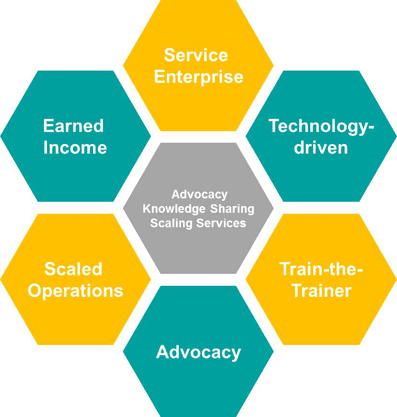At some point in the life of a nonprofit, it’s likely that a nonprofit leader will consider scaling their organization to maximize impact. Many nonprofits assume that scaling simply implies large-scale growth and is attainable only by well-funded celebrity organizations. As Chip and Dan Heath highlight in their book Switch: How to Change Things When Change is Hard, ambiguity is the enemy of taking that first step to reach your goals.
The nonprofit sector is extremely diverse, and there is neither a one-size fits all model nor a single path to scaling greatness. However, the development of a common framework for scaling impact is both possible and necessary—not only to maximize a nonprofit’s impact, but also to help funders better support nonprofits considering large-scale change.
This series is intended for funders and nonprofits interested in investing in proven scaling models. I will provide a lens through which funders can understand the unique circumstances surrounding their nonprofit grantee and identify the approach to scaling that works best for them. I also will provide nonprofits with some key insights—including characteristics of effective scaling models and examples of organizations that exhibit these traits – as they design a clear model for scaling their organizations’ impact.
At Taproot, we began our research with the question: How can we identify discrete paths for nonprofits to scale their impact and guide funders on best ways to support their scaling efforts? What we discovered differed dramatically from common perceptions of nonprofit scaling, which we can break into three myths:
Myth 1: Scaling is an amorphous concept with no clear definition or discrete path for achievement. Fact: The paths to scale are finite and more science than art. The organizations that have come closest to realizing their visions have taken one or more of these three directions for scaling their impact: advocacy, knowledge sharing, and scaling services. And there are six proven levers to scale impact effectively.
Myth 2: In order to scale, nonprofits need to be exceptional across all competencies and functions. Fact: Organizations need to be exceptional only in a few functions and good in many. Basic readiness requires these core competencies: 1) strong leadership, 2) effective talent management, and 3) an outcomes/metrics orientation. From there,, nonprofits need to match their organizational capacities to the right strategy for growth.
Myth 3: Some nonprofits are born to scale. Fact: Many nonprofits don’t start with scaling in mind but are drawn in that direction once underway.
Through our research, we have identified six building blocks for scaling impact that are fundamental to developing a framework for scale. The framework itself will allow funders to develop a constructive dialogue, ultimately allowing for more effective partnership with nonprofits that will help determine the most appropriate paths for scaling.

Over the next few weeks, I will provide an in-depth analysis of each of the following models, and provide examples of organizations that exemplify these traits:
- Service Enterprise. These organizations effectively utilize volunteers to do core function work in the organization.
- Technology Driven. These organizations effectively leverage technology to lower costs in distributing information, delivering services, and generating large individual donor support.
- Train-the-Trainer. These organizations excel at finding ways to package a model that other organizations or a network of volunteers can use to offer the same services in other communities.
- Advocacy. These organizations work to influence the institutional, societal, and governmental systems that relate to the nonprofit’s chosen issue areas so that they can change the playing field, not just their position in it.
- Scaled Operations. These organizations develop a replicable model that enables it to effectively scale its operations across geographies. In doing so, they can spread the costs of the core operations infrastructure across program sites.
- Earned Income. These organizations focus on growing an income earning strategy to decrease dependency on traditional funding.
I will discuss each of these models in depth and provide examples of organizations that illustrate these traits. I hope to provide readers with a roadmap to effective scaling that many of the most successful organizations have found useful.
Support SSIR’s coverage of cross-sector solutions to global challenges.
Help us further the reach of innovative ideas. Donate today.
Read more stories by Aaron Hurst.

